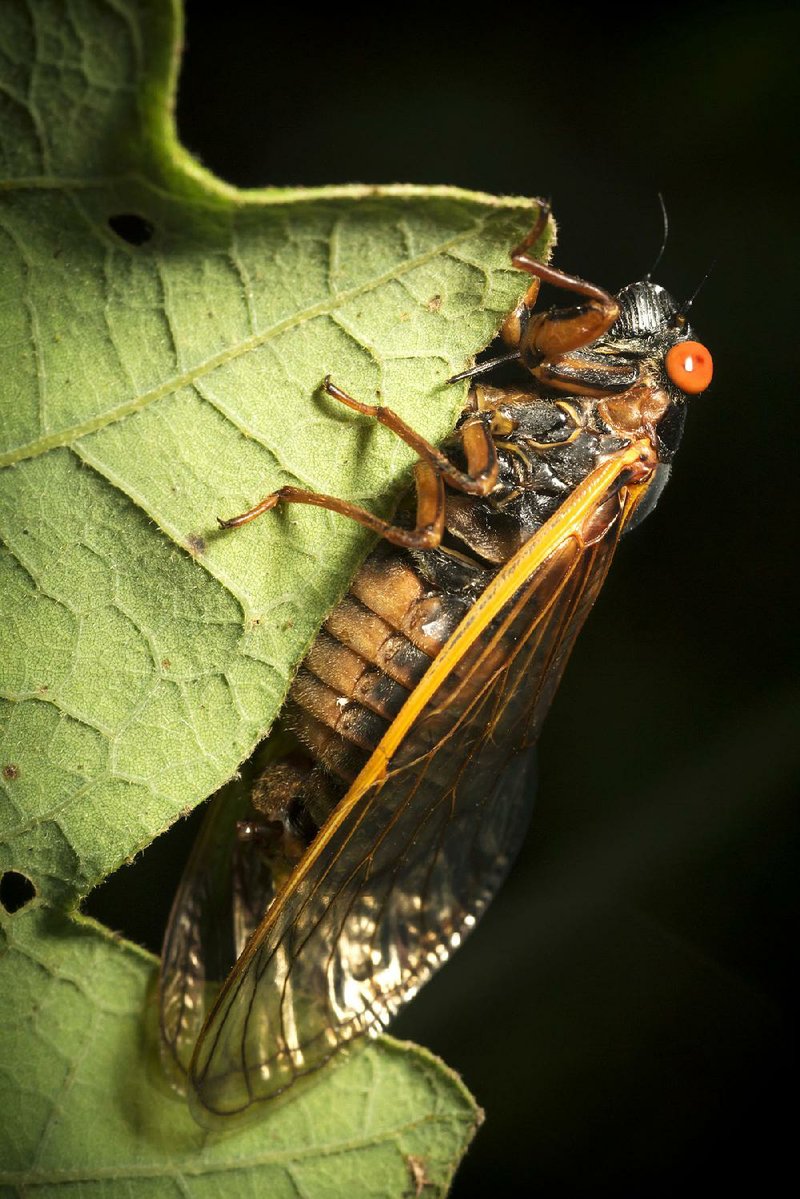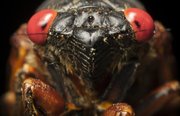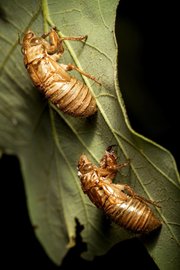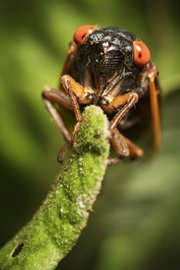Alien spaceships are not hovering over Arkansas.
This assurance comes on good authority: Bryant Police Chief Mark Kizer, in response to fellow citizens who made worried calls to 911 in late May to report eerie sonic disturbances in their neighborhoods. Kizer advised his department's 13,000 Facebook followers that the city was experiencing something unusual but quite natural: periodical cicadas.
When calls to 911 continued even after delighted news media picked up the story of townspeople askeered of bugs, Kizer wrote on the Facebook page: "Yes the 911 calls are continuing and yes people are persistent that it's an alarm or a strange noise. We cannot turn the Alarm off because there is no alarm, yes we are sure there is no alarm. Yes we will be glad to respond and see you so we can hear it at your house.
"No we are not kidding that noise is really insects but no worries it will not last long the mothership will run out of fuel and go back soon to their 'UnderGroundPlanet .' ..."
What is happening is the emergence of millions of 13-year cicadas in Bryant and around the state and nation.
In honor of these insect masters of noisy massing, here are 13 other things that also are not happening at this time.
1 Cicadas are not invading Arkansas.
They have not swarmed upon us. They have not returned once again to the forests, the parks, the farm where you live.
They reside here. They never leave.
2They are not hatching. Every single one of these millions of cicadas is 13 years old. They hatched on some unfortunate plants during President George W. Bush's first term.
After hatching, white, termitelike nymphs dropped to the soil and commenced clawing their way down, down to the tips of tree roots.
Unlike June bug larvae (which look like shrimp grubs would look if shrimp made grubs), startup cicadas -- instars -- look like wingless ... cicadas. They molt several
times, until they look like ... larger wingless cicadas.
Those that escaped being eaten by moles and centipedes have been diligently stealing sap and molting into ever larger not-grubs, until recently. As the soil 7 or 8 inches down warmed to 64 degrees, they clawed to the surface, scurried to the nearest vertical, stiff item -- generally a tree -- clambered up and -- those that weren't gobbled by copperheads, robins or box turtles -- molted one last time.
3 Cicadas are not shedding their skin.
They don't have skin. Their final de-husking, called ecdysis, leaves behind a caramel-colored, translucent, empty, cicada-shaped cuticle.
Factoid: From the word ecdysis, midcentury smart-aleck H.L. Mencken coined the word ecdysiast, meaning a striptease artist.
4 This emergence is not an emergency. It comes as no surprise.
Humanity has been aware of cicada behavior since the hot afternoon in ancient Greece when Socrates turned to Phaedrus and asked if he'd heard the one about the men who sang so much they forgot to eat or drink and died -- and then the Muses turned them into buglike insects. (See Plato's dialogue Phaedrus, section 259 and following. Find a translation that doesn't refer to grasshoppers or locusts.)
Today's massively loud cicadas are not Arkansas' only cicadas. More common cicadas with shorter life cycles will emerge later this summer, and as they do every year, their late-afternoon thrummings in July and August will make elderly Arkansans wistful for long-gone porch swings and the rattle of screened doors.
Instead, we are hearing a (figuratively) magical brood of the genus Magicicada -- so named by scientists impressed by their habit of emerging en masse simultaneously after more than a decade underground.
Kimberly Smith, distinguished professor of biological sciences for the University of Arkansas at Fayetteville, posted to the birding listserv ARBird-L that central and eastern Arkansas are experiencing the mass emergence of three 13-year Magicicadae species collectively known as Brood XXIII.
The three species emerging together -- cassini, decim and decula -- are easily distinguished by their calls, Smith wrote. "About 15 years ago, a fourth species was described from northern Arkansas: Magicicada neotredecim. It also is emerging this year and apparently sounds like decim."
Brood IV, cicadas with a 17-year cycle, is emerging in Kansas, Oklahoma, northern Texas and extreme southwestern Arkansas.
Brood XIX, also 13-year Magicicadae, emerged four years ago throughout Arkansas.
Researchers track these brood emergences. One online project, begun by John Cooley, an entomologist at the University of Connecticut, recruits citizen scientists to report GPS coordinates that are plotted onto digital maps at magicicada.org.
Another University of Connecticut site that invites citizen participation is the Simon Lab Nymph Tracking Project at bit.ly/1J4OlIK.
5 Cicadas are not glowering behind their angry, red eyes.
Insects, emotionally, are like robots.
Besides, only some of them have red eyes.
"They can also have white, gray, blue, yellow or multicolored eyes," Smith told the Arkansas Democrat-Gazette. He is not sure what advantages the various eye colors might convey.
A FAQ on magicicada.org explains that they see very well:
"They have five eyes (two large red compound eyes on the sides of the head, and three small ocelli [simple eyes] located in a triangle on the front of the head). ... Even the nymphs can see when they emerge from their burrows to metamorphose -- they can head towards a tree (or your leg!) -- anything vertical -- in the near-darkness from many meters away."
6 They are not fighting to the death for a mate. But they are racing, and as soon as a female responds, the males fixate on her and head her way, undeterred by any obstacles and/or threats to life or limb.
Large groups of males collect in tree branches where they use a hollow sounding-chamber in their abdomens to make raucous, ratcheting noises followed by a down-slur. These noises attract the females, leading to great treetop gatherings of male and female cicadas called "choruses."
Females signal their readiness to mate by flicking their wings. That motion produces a simple click.
In a memorable episode of Sir David Attenborough's BBC series Life in the Undergrowth, he lures a male cicada onto his wrist by snapping his fingers. This episode can be viewed on Youtube.
In an even more memorable article posted on the website of PBS Newshour, "How to Woo a Cicada," researcher Cooley flips a light switch a few times, so fixating a male cicada that Cooley is able to pick it up and put it in his mouth without the insect trying to get away. (to.pbs.org/1EA0WM1)
7 Cicadas do not eat leaves.
If they were locusts -- which they are not -- trees would be in dire straits, because locusts are like grasshoppers and have voracious mouthparts.
But cicadas can hurt small or weak trees and reduce fruit crops.
After mating, the female uses a scalpel-sharp egg-planting tube to pierce tender bark and slip in her eggs. According to the University of Michigan's Animal Diversity Web, "When female Magicicadas cut slits and lay eggs in twigs, the twigs may split, wither, and die. This problem, known as flagging, is not serious for mature trees, but it can greatly harm young trees."
The University of Arkansas Cooperative Extension Service's department of plant pathology newsletter for March 28, 2012, includes sad photos of liriodendron and arborvitae branches damaged by egg-laying cicadas.
8 They will not bite you.
See above, about the mouth parts.
9 They are not really singing and/or howling. It's not about self-expression.
Researchers have isolated six sounds, not all of which are made by every species of these insects, and each species has distinctive calls.
Besides the female flicking, there's an alarm buzz, a clacketty whirring anyone can experience by picking up a cicada that hasn't yet fixated upon a mate.
A noise called a "calling song" attracts males and females alike. Males alternate a few seconds of this call with brief flights that carry them closer to an answering female.
Then there are three calls produced by males in proximity to females which, for delicacy's sake, can be termed "courting calls."
10 They are not all over the place.
One doesn't need to look at a researcher's website to notice this. In some neighborhoods where summer cicadas emerge year after year, no cicadas are active right now. To support periodical cicadas, ground needs to remain undisturbed for decades.
A study of common cicadas conducted by researchers at Arkansas State University at Jonesboro and published in August by the journal Environmental Entomology looked into why the annual insects come out here and there but not everywhere in a bottomland forest.
They saw more cicadas emerging in areas with more saplings. Often there are more saplings closer to the edge of the forest. Their report concludes such places provide favorable spots for the females to deposit eggs while also allowing for nymph survival.
"The differences in nymph densities between areas of our system were likely a result of the differential effects of flooding in these areas," the researchers added. They conclude that flooding might hurt common and also periodical cicadas.
11 Cicadas will not crawl into the ground to sleep for another 13 years. They will not hibernate.
These two weeks or so above ground are it for the adults. But they have ample opportunities to scramble hither and yon or fly about a bit in search of a mate, to court the mate, mate and either find a decent stretch of bark in which to deposit eggs or to wobble around until they encounter a dragonfly or carnivorous bird.
Eventually all cicadas must die.
12 Their lives are not useless.
Cicadas are edible. Just because you don't want to eat them doesn't mean other creatures won't.
A news release posted by the Cooperative Extension Service quotes entomologist Gus Lorenz as noting that "birds eat so many that they can't even fly away."
Around the world, cicadas are an important food for humans, and thus was it ever so. Another ancient Greek, Aristotle, wrote in his Historia Animalium: "The larva of the cicada on attaining full size in the ground becomes a nymph; then it tastes best, before the husk is broken." Of the adults, he wrote, females taste best when full of eggs.
According to the United Nations Food and Agriculture Organization report "Edible insects: Future Prospects for Food and Feed Security" (bit.ly/1ixCl5P), of the more than 1,900 edible insect species on Earth, Hemiptera -- cicadas, leafhoppers, planthoppers, scale insects and true bugs -- make up about 10 percent of the diet of 2 billion people.
13 The land will not fall eerily silent when this emergence is done. Arkansas is also home to annual cicadas, which will emerge and begin their chorusing.
And, of course, summer's most vocal nighttime noisemakers are not cicadas but crickets, katydids and treefrogs.
ActiveStyle on 06/01/2015



